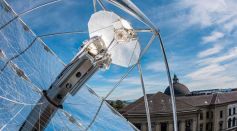CHEMISTRY

ABSTRAX Pins the Exact Origin of Cannabis’ Distinctive Skunk-Like Aroma in Scientific Peer-Reviewed Study

For the First Time Large Hadron Collider FASER Experiment Reveals Ghost Particle Neutrinos

Chemists Developed Novel Approach to Extract Rare Earth Element from Electronic Wastes Through Nanotechnology

Airplane Fuel From Sunlight and Air: New Plant Can Produce Carbon Neutral Fuel for Sustainable Aviation and Maritime Transportation

Newly Created Superionic Ice May Give Insight on Planetary Formation and Location of Life in the Universe
Mercury Poisoning: 370 Human Bones From Spain and Portugal Contains Highest Levels Of Chemical Element Due To Cinnabar Exposure

Creating Shape-Shifting Materials: Exploding, Weeping Ceramics Opens New Path to Improve Electronics and Medical Devices

Air Pollution Decrease in India During COVID-19 Lockdown Not as High as Originally Thought
Copper Age Iberia Discovered to Hold the Largest Mercury Poisoning Record Throughout Human History; How Dangerous Is It?
Waste Turned Into Fatty Acids; Study Reveals New Process That Produces Energy-Rich Molecules to Make Fuels, Other Essential Chemicals

Origins of Heavy Metals: Researchers Use Computer Simulations to Determine Where Gold Comes From
Mineralogist Discovers Mineral 'Davemaoite' Trapped In a Diamond From Earth's Mantle

ETH Zurich Develops Sustainable Syngas from Natural Carbon Dioxide and Solar Energy, A Potential Replacement For Fossil Fuels

Cow Manure Turned Into Filter to Make Drinking Water from Seawater
Most Popular

How AI Is Used in Weather Prediction: Smarter Forecasting Through Machine Learning

De-Extinction vs. Conservation Science: Which Approach Protects Biodiversity Most Effectively?

The Future of Clean Tech: Exploring the Next Generation of Renewable Energy Breakthroughs

Geoengineering and Climate Intervention Science: Can We Really Engineer a Cooler Planet?





